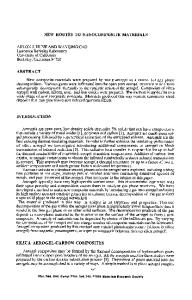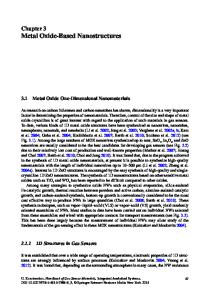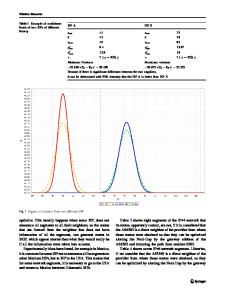New Routes To Metal Chalcogenide Nanostructures
- PDF / 1,297,269 Bytes
- 5 Pages / 612 x 792 pts (letter) Page_size
- 105 Downloads / 472 Views
B9.2.1
New Routes To Metal Chalcogenide Nanostructures. Paul Christian and Paul O’Brien. School of Chemistry & The Manchester Materials Science Centre, University of Manchester, Oxford Road, Manchester, M13 9PL, UK. E-mail [email protected], paul. o’[email protected].
Abstract There is considerable current interest in the synthesis of metal chalcogenide nanostructured materials1 especially for the manufacture of so called 3rd generation solar cells. The facile, large scale, synthesis of such materials is critical to enabling such technology. The synthesis of these materials, especially those of cadmium, has been widely discussed in the literature. However, whilst routes involving pyrophoric materials give high quality particles and structures2, their inherent reactivity results in complications in handling. Although the use of acetates has already been shown to give good results,3 there are, in general, problems in the synthesis of tellurium containing materials.4 This paper describes a new method providing a general synthesis of metal chalcogenide nanomaterials in a TOP/TOPO reaction system involving easy-to-handle reagents. Results for cadmium will for the basis of the discussion, which will include examples from a wider range of metals. The use of cadmium acetate in TOP and solutions of chalcogenides in TOP in the presence of suitable reducing agents provides an exceptionally reactive system. The system is flexible and may be applied to a wider range of chalcogenide based nanomaterials.
Introduction In order to understand and expand the area of metal chalcogenide synthesis it is important to have a simple system which may be applied to a wide range of metals and all three chalcogenide species. Whilst there is a wealth of literature on the synthesis of cadmium chalcogenides, there are very few examples of simple methods which are both easy to implement and use easy to handle staring materials or procedures. The application of many methods to a range of metals can be complicated by the requirement of the metal component to be a metal alkyl. In this paper we report a gradual addition process that utilises a very rapid reaction between the metal and the chalcogenide precursors. This allows the method to be applied to a range of reaction systems and allows very narrow particle size distributions to be achieved.
Experimental Cadmium acetate, zinc acetate, sulphur, selenium, tellurium, catacol, trioctyl phosphine, trioctylphosphine oxide, octylamine, octadecene, toluene and methanol were obtained from Aldrich. The metal salts were dried by recrystallisation from acetic anhydride and the toluene and methanol were dried over sodium and calcium hydride respectively. TEM images were collected by dispersing the particles in toluene and evaporating a droplet onto a carbon coated
B9.2.2
copper grid. A Philips CM200 was used for imaging with a beam of 200 kV. The P-XRD data were collected on a Brucker D8 diffractometer. The photoluminescence data was recorded on a Horiba Fluorolog-3 (FL3-22) photoluminescence spectr
Data Loading...











